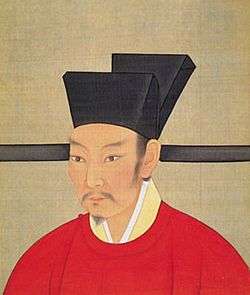Emperor Qinzong
| Emperor Qinzong of Song 宋欽宗 | |||||||||||||
|---|---|---|---|---|---|---|---|---|---|---|---|---|---|
 | |||||||||||||
| Emperor of the Song dynasty | |||||||||||||
| Reign | 19 January 1126 – 20 March 1127 | ||||||||||||
| Predecessor | Emperor Huizong | ||||||||||||
| Successor | Emperor Gaozong | ||||||||||||
| Born |
Zhao Huan 23 May 1100 | ||||||||||||
| Died | 14 June 1161 (aged 61) | ||||||||||||
| Empress | Empress Zhu | ||||||||||||
| Concubines |
| ||||||||||||
| Issue |
| ||||||||||||
| |||||||||||||
| House | House of Zhao | ||||||||||||
| Father | Emperor Huizong | ||||||||||||
| Mother | Empress Xiangong | ||||||||||||
| Emperor Qinzong of Song | |||||||
| Traditional Chinese | 宋欽宗 | ||||||
|---|---|---|---|---|---|---|---|
| Simplified Chinese | 宋钦宗 | ||||||
| Literal meaning | "Venerate Ancestor of the Song" | ||||||
| |||||||
| Zhao Ji | |||||||
| Traditional Chinese | 趙桓 | ||||||
| Simplified Chinese | 赵桓 | ||||||
| |||||||
| Marquis Chonghun | |||||||
| Chinese | 重昏侯 | ||||||
| Literal meaning | Doubly Besotted Marquis | ||||||
| |||||||
Emperor Qinzong of Song (23 May 1100 – 14 June 1161), personal name Zhao Huan, was the ninth emperor of the Song dynasty in China and the last emperor of the Northern Song dynasty.
Emperor Qinzong was the eldest son and heir apparent of Emperor Huizong. His mother was Emperor Huizong's empress consort, Empress Wang. In 1126, when the forces of the Jurchen-led Jin Empire invaded the Song Empire during the Jin–Song Wars, Emperor Huizong abdicated and passed on his throne to Emperor Qinzong, and then assumed the title Taishang Huang ("Retired Emperor") himself. Left to deal with the Jin invasion, Emperor Qinzong appointed the general Li Gang (李綱) to lead the Song military to fend off the invaders. However, the emperor was not a decisive leader and often made poor judgments. Eventually, he removed Li Gang from his appointment in the hope of starting peace talks with the Jin Empire. However, Jin forces eventually breached the walls of the Song capital, Bianjing, in 1127 and occupied the city in an event historically known as the Jingkang Incident ("Jingkang" was the era name of Emperor Qinzong's reign). Emperor Qinzong, along with his father Emperor Huizong and the rest of their family, were taken prisoner by Jin forces. This event also marked the end of the Northern Song dynasty. One of Emperor Huizong's sons managed to escape to southern China, where he reestablished the empire as the Southern Song dynasty and became historically known as Emperor Gaozong.
Emperor Qinzong and his father were demoted to the status of commoners on 20 March 1127 and deported to Huining Prefecture, the Jin capital, on 13 May 1127. In 1128, the two former Song emperors were forced to wear mourning dress and pay homage to the ancestors of the Jin emperors at their ancestral temple in Huining Prefecture.[1][2] Furthermore, the Jurchen ruler, Emperor Taizong, gave the two former Song emperors contemptuous titles to humiliate them: Emperor Qinzong was called "Marquis Chonghun" (重昏侯; literally "Doubly Besotted Marquis") while Emperor Huizong was called "Duke Hunde" (昏德公; literally "Besotted Duke").[2]
In 1141, as the Jin Empire normalised relations with the (Southern) Song Empire, the Jurchens renamed Emperor Qinzong's title to the more neutral-sounding "Duke of Tianshui Commandery" (天水郡公), which is based on a commandery located in the upper reaches of the Wei River. A few months later, the former emperor started receiving a stipend due to his nobility status. He lived the rest of his life as a captive in the Jin Empire, which used him as a hostage to put pressure on the Song Empire.[2]
Emperor Qinzong died as a sick and broken man in 1161.[3] He was 61. His temple name means "Esteemed Ancestor".
Family
- Spouse: Empress Zhu, bore Zhao Chen
- Concubines:
- Lady Zhu (朱氏), formally known as Consort Shende (慎德妃), bore Zhao Jin and Lady Zhao#2
- Zheng Qingyun (鄭慶雲), cairen, bore Zhao Xun
- Han Jingguan (韓靜觀), cairen
- Liu Yue'e (劉月娥), cairen
- Lu Shunshu (盧順淑), cairen
- He Fengling (何鳳齡), cairen
- Di Yuhui (狄玉輝), cairen, bore Lady Zhao#1
- Qi Xiaoyu (戚小玉)
- Zheng Yuegong (鄭月宮)
- Jiang Changjin (蔣長金)
- Bao Chundie (鮑春蝶)
- Sons:
- Zhao Chen (趙諶), Crown Prince (太子)
- Zhao Jin (趙謹)
- Zhao Xun (趙訓)
- Daughters:
- Princess Roujia (柔嘉公主)
- Lady Zhao#1 (趙氏)
- Lady Zhao#2 (趙氏)
See also
- List of emperors of the Song dynasty
- Jin–Song Wars
- Architecture of the Song dynasty
- Culture of the Song dynasty
- Economy of the Song dynasty
- History of the Song dynasty
- Society of the Song dynasty
- Technology of the Song dynasty
Notes
References
- Jing-shen Tao (1976) The Jurchen in Twelfth-Century China. University of Washington Press. ISBN 0-295-95514-7.
- Herbert Franke, Denis Twitchett. Alien Regimes and Border States, 907–1368 (Cambridge History of China, vol. 6). Cambridge University Press, 1994. ISBN 0-521-24331-9. Partial text on Google Books.
| Emperor Qinzong Born: May 23 1100 Died: June 14 1161 | ||
| Regnal titles | ||
|---|---|---|
| Preceded by Emperor Huizong |
Emperor of the Song Dynasty 1126–1127 |
Succeeded by Emperor Gaozong |